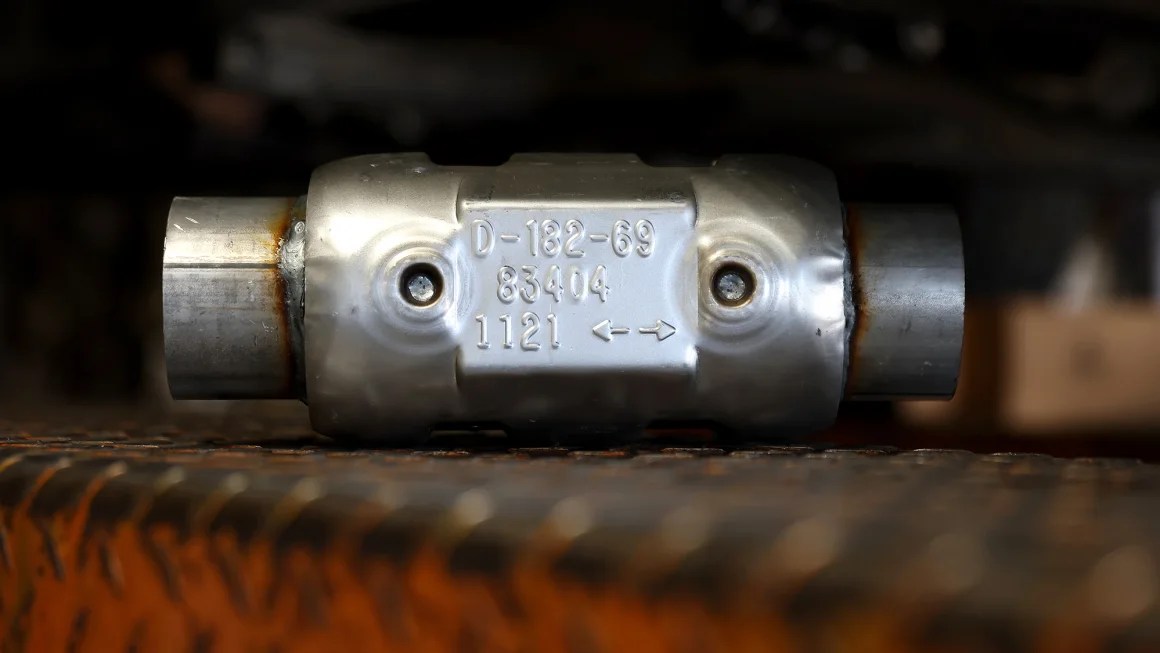Johnny Wactor, an actor who formerly starred in “General Hospital,” caught people in the act of stealing the catalytic converter from his car Saturday. Tragically, one of the thieves, according to witnesses and Los Angeles police, then shot and killed Wactor.
It’s rare for someone to be murdered over a catalytic converter but thefts of this car part remain stunningly frequent. Last year, thieves stole 27,609 catalytic converters in the US, with more than half of those thefts happening in California, according to the National Insurance Crime Bureau. That’s down sharply from the more than 64,700 that were stolen in 2022. But, up to last year, catalytic converter thefts had been rising sharply, up by a factor of four, since 2020.
It might seem odd that this particular car part would attract so much criminal attention, especially one with such an innocuous purpose. A catalytic converter cleans a car’s exhaust, making the air safer to breathe for all of us. On its website, the US Environmental Protection Agency has called the catalytic converter “one of the great environmental inventions of all time.” But it’s not what the catalytic converter does that attracts desperate criminals. It’s what’s inside.
Often, there’s platinum, worth more than $1,000 an ounce, palladium, worth nearly as much, and rhodium, worth almost $5,000 per ounce. They react chemically with exhaust gases, breaking down compounds like carbon monoxide, nitrous oxides and small amounts of unburned fuel into less harmful substances.
A catalytic converter is a metal cylinder or flattened oval that’s part of the car’s exhaust system. It’s usually underneath the car with an exhaust pipe running in one end and out the other. Inside is a honeycomb-like structure coated in metals far more valuable than gold.
Easy to steal
Carlos Juan Hernandez replaces a catalytic converter on a 2001 Honda Accord at Anchor Muffler in Anaheim, CA on Friday, December 14, 2018. A catalytic converter is a emission control device on a cars muffler. (Photo by Paul Bersebach, Orange County Register/SCNG)
Those metals, plus the catalytic converter’s exposed position, make it a target for theft. Also, unlike some other car parts, catalytic converters are usually not marked with a vehicle identification number, making it difficult to track a stolen converter back to an actual theft.
Unlike with other car parts that are under the hood, locking a car won’t necessarily deter a catalytic converter thief who can crawl underneath the car and saw through the exhaust pipe. The popularity of SUVs, which are higher off the ground, has made the job even easier.
But while those prices sound astoundingly high, they’re actually much lower than they’ve been in recent years. A couple of years ago, rhodium was worth almost $30,000 an ounce. That, plus increased law enforcement around these thefts and higher penalties for those who steal convertors or purchase stolen ones, contributed to recent declines in thefts, according the NICB.
Also, as car engines have becoming more efficient and cleaner-burning, catalytic converters have been made smaller and with less metal, said Richard Waitas, a senior manager at the exhaust components company MagnaFlow. There simply isn’t as much dirty exhaust gas they need to clean and this is one reason thieves may target older models.
Limiting thefts
ExperTec Automotive technician Juan Martinez etches a catalytic converter with the car’s license plate number in Huntington Beach on Saturday, November 13, 2021. The free public service, sponsored by local police departments, aimed to deter thefts. Converters are increasingly being stolen for the precious metals they contain. (Photo by Mindy Schauer, Orange County Register/SCNG)
Some newer cars have at least one catalytic converter – vehicles can have more than one – close to the engine where it works more efficiently because it stays hotter, said Waitas. That’s also helped deter some theft because the converter is just harder to reach up close to the engine block.
Federal legislation that is currently being considered would require catalytic converters to be marked with identifying numbers so stolen converters could be tracked back to specific cars, making the crime easier to prosecute. The National Automobile Dealers Association is actively pushing for the new law, the Preventing Auto Recycling Theft (PART) act, a spokesperson said.
Used catalytic converters can sell for anywhere from $25 to $1,000, depending on the metals content, which varies by a vehicles make and model, according to Scott Vollero and Christopher Gaines, who co-founded ScrapCATapp.com, an auction site for used catalytic converters.
Related Articles
Mob break-in targets Santa Cruz County marijuana dispensary
Armed robbers hit luxury store in Paris reported to be ‘Jeweler to the Stars’
Mail carrier robbed of postal keys in Palo Alto
5 arrested, including 3 minors, in Polo Ralph Lauren store theft at California mall
CHP stolen vehicle chase ends in Highway 17 crash, fire
For the most part, the catalytic converters end up getting sold to recycling companies that strip out the materials to make new catalytic converters. Recycling is far cheaper than relying on new, mined metails, said Waitas. And no matter how old a catylitic converter is, those metals are still there.
“That cat will always contain those metals and all you’ve got to do is go through the process of removing the metals from the substrate and whatever contaminants,” he said.
For the the victim, of course, the price is much higher as replacing a catalytic converter can cost more than $2,000 including parts and labor.
While it might not sound like it would matter much, getting the catalytic converter stolen can can make a car virtually undrivable. If your catalytic converter is stolen, the first thing you’ll likely notice is the sound. When you start the engine the car will be really loud because, with the exhaust pipe cut, exhaust won’t be channeled through the car’s muffler anymore. Thats the part that reduces, or muffles, engine sound.
Then you’ll notice the orange “check engine” light and you’ll probably also notice the smell of untreated exhaust fumes wafting up. If you persist in driving, you may also notice uneven acceleration because the engine isn’t being forced to push the exhaust down that long pipe and through the catalytic converter and the muffler, anymore. Since the engine was set up to deal with that back-pressure, not having a working exhaust system will cause performance issues.
If this happens, don’t drive the car. Report the theft to police and your car insurance company. Get the catalytic converter replaced. The good news is, these days, it’s at least a little less likely to happen. And electric vehicles, which are gaining market share, don’t have catalytic converters to steal in the first place.
The-CNN-Wire
& © 2024 Cable News Network, Inc., a Warner Bros. Discovery Company. All rights reserved.












